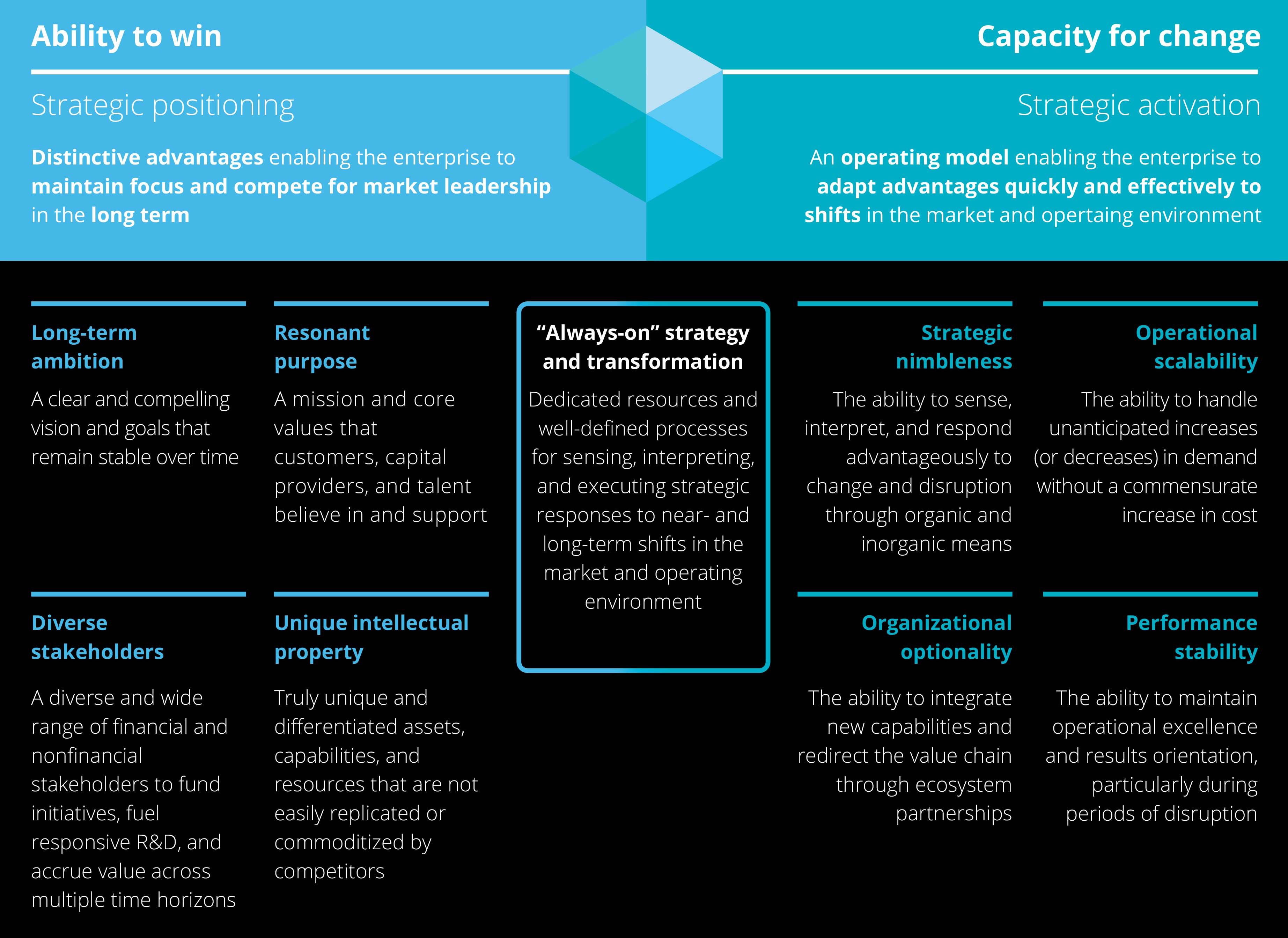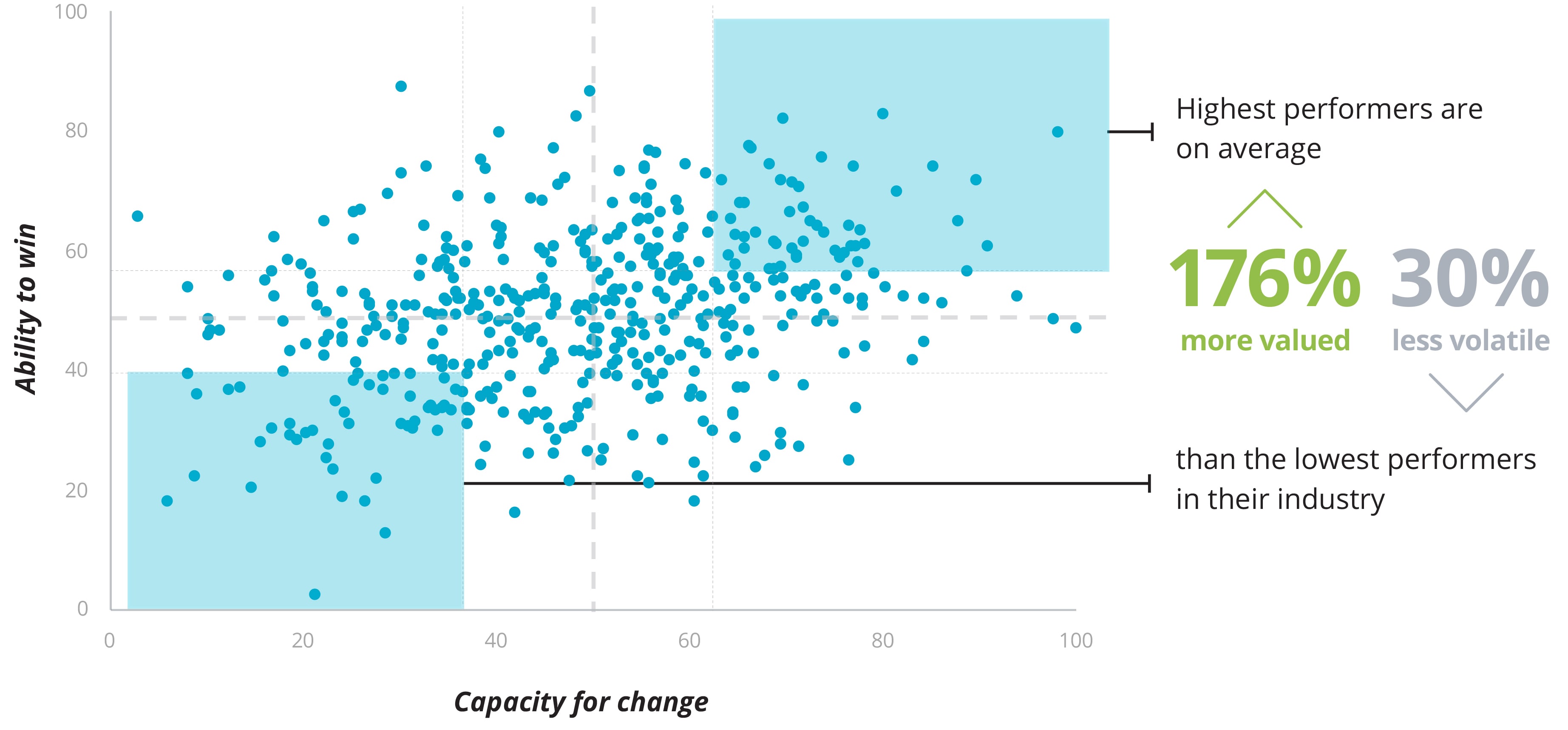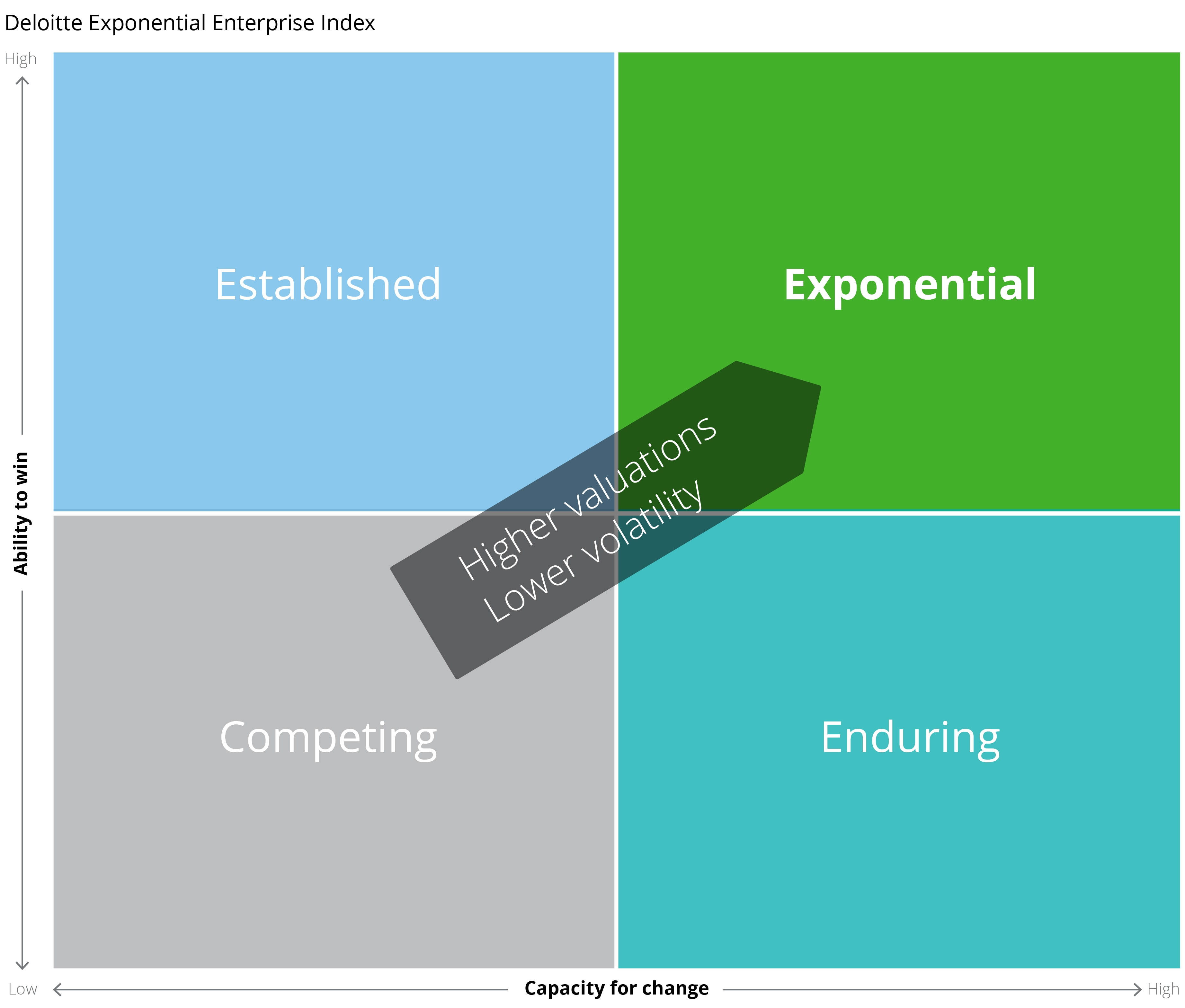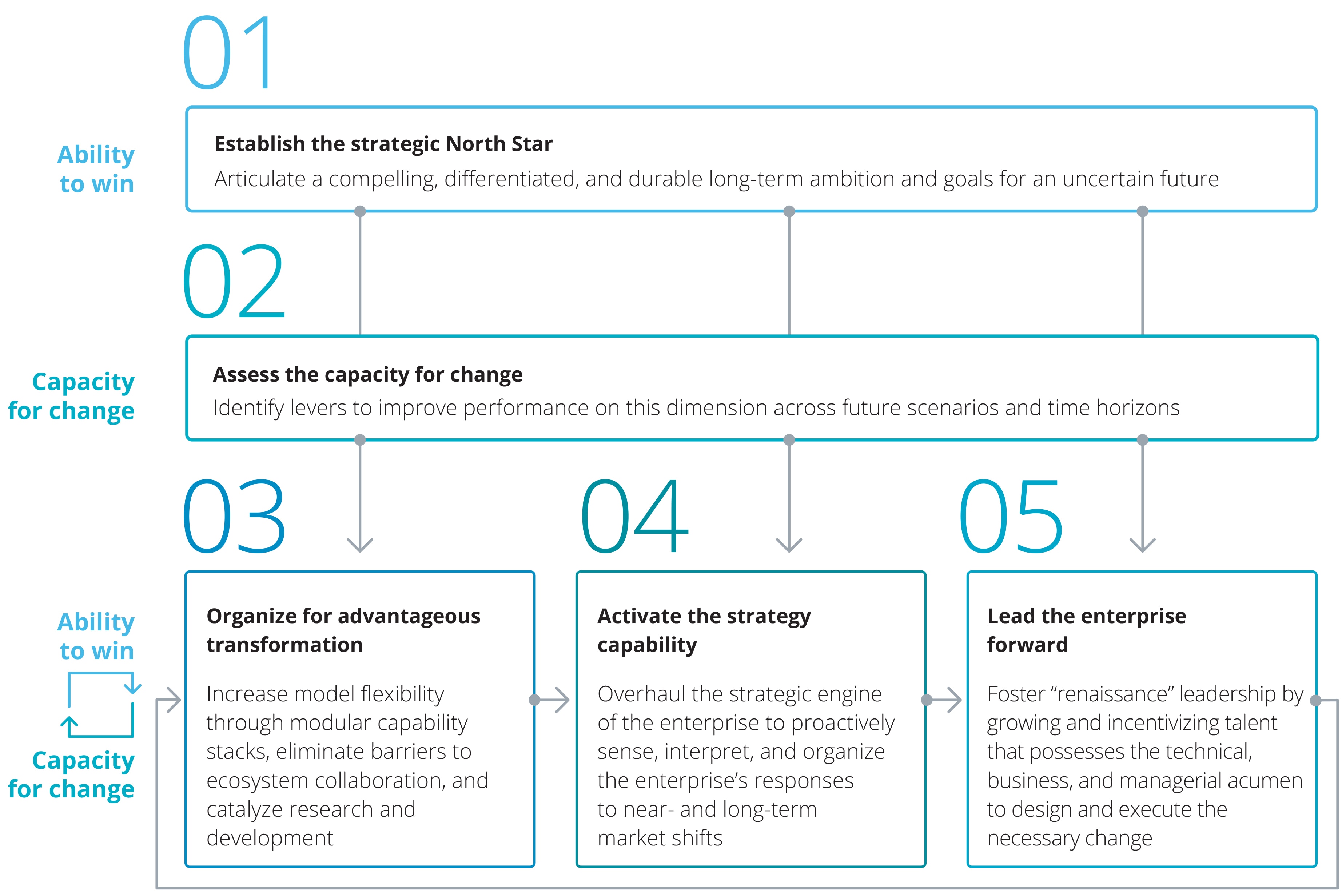The exponential enterprise
Fortifying the ability to win through the capacity for change

Catalysts for change
Operating environment: A ball of confusion
CEOs are navigating a less predictable, increasingly complex, and rapidly changing operating environment. Technological innovation is accelerating disruptive forces that are reshaping societies, marketplaces, and policies on a global scale. These shifts create three new challenges for leaders of the 21st century enterprise:
- The speed and complexity of change sustains volatility, uncertainty, complexity, and ambiguity (VUCA). This widens the range of scenarios and forces choices in shorter time frames with less certainty.
- Acute and chronic disruptions multiply and amplify at faster rates, shifting from a singular, repairable event to a continuous, compounding condition.
- As technology compresses traditional risk mitigants—distance and time—disruptive forces shape and reshape wider swathes of the operating environment, making threats more existential, interconnected, and sudden; the COVID-19 pandemic provides an initial case study.
Most leaders expect these conditions to persist, yet few are confident in their enterprise’s ability to respond. These ongoing and amplifying VUCA conditions complicate long-term strategic planning and decision-making for enterprise leaders and will continue to do so unless they are solved for.
Most enterprises believe disruption is here to stay, but face significant barriers to adapting their long-term strategic planning and decision-making to this new reality.
of global CXOs believe that disruptions like those seen in 2020 will continue in the future
of CXOs are not confident in their organizations’ ability to pivot and adapt to disruptive events
of CEOs believe their biggest mistake during the pandemic was not acting fast enough
Characteristics of winners
Ability to win and the capacity for change
Traditional transformation initiatives (e.g., modernization, optimization) alone cannot keep up. Exponentially increasing technological sophistication and its corresponding impact on the broader operating environment require a wholesale reconsideration of the purpose, organization, and leadership of a firm’s business structure. The answer is a redesigned exponential enterprise.
Exponential enterprises embrace these changes by orienting their businesses around two dimensions:
- An ability to win, representing the few and only things the business wants to protect from change: a long-term strategic vision and goals supported by distinctive assets and capabilities that retain value in various future scenarios
- A capacity for change, comprising the operating model, capabilities, and leadership that allow the business to rapidly and flexibly adapt how it positions, delivers, and monetizes its ability to win
Both dimensions are required for long-term success. The ability to win comprises all-weather value drivers that, if properly positioned, packaged, and nurtured, can propel the enterprise through a wide range of potential future scenarios. The capacity for change provides the foundation for the enterprise to adapt continuously and advantageously in the face of change. Always-on strategy and transformation capabilities, both long- and short-term, mutually reinforce these two dimensions.
Ability to win and capacity for change

The value of the exponential enterprise
Deloitte Exponential Enterprise Indices
Because tangible enterprise design elements (assets, capabilities, and processes) sit behind each of these characteristics, an enterprise can measure its ability to win and capacity for change and compare both to industry competitors. To quantitatively measure a company’s ability to win and capacity for change, Monitor Deloitte developed the Deloitte Exponential Enterprise Indices.
Monitor Deloitte quantitative analysis shows that exponential enterprises—those that rank highly on both ability to win and capacity for change relative to others in their industry—benefit from higher and more stable shareholder valuations and more consistent financial performance, allowing them to attract more capital and talent by signaling an ability to create durable competitive advantage.
Deloitte Exponential Enterprise Index results

Most of our analysis focuses on defining and creating exponential enterprises, but the indices also reveal three other foundational enterprise archetypes, each characterizing distinct strategic implications for how companies must organize, invest, and lead to become more valued, more stable exponential enterprises.

Established enterprises have well-articulated strategic visions and differentiated intellectual property, but are quick to drift away from strategy and tend to react tactically when confronted with disruptive challenges. They maintain capital-intensive operating models that drive investments into legacy fixed assets rather than R&D or new technologies. Established enterprises enjoy thick, but volatile and slowly eroding margins.
Exponential enterprises are guided by a long-term strategic North Star and outpace competitors in responding to technological, governance, and social trends. They prioritize strategic investments in the ability to win and capacity for change, even during times of crisis and disruption. Exponential enterprises leverage ecosystems, partnerships, and M&A to gain efficiency and access to strategic markets and capabilities.
Competing enterprises often lack differentiated intellectual property and are slow to respond to technological, social, and governance trends. They maintain a short-term orientation toward investments and performance. Competing enterprises have limited external partnerships, outdated technological capabilities, and low valuations that tend to fall further during crises.
Enduring enterprises are oriented to near-term growth, mostly from performance efficiency and opportunistic M&A. They maintain capital-light operating models and respond nimbly to acute disruption. However, enduring enterprises are less likely to embrace a long-term strategic vision and have difficulty sustaining competitive advantage and long-term enterprise value.
Exponential enterprises tend to stay exponential. The ability to win and the capacity for change mutually reinforce each other, enabling companies to achieve and sustain superior performance and valuations over time, especially during periods of adverse and disruptive market conditions.
During the COVID-19 pandemic, 94% of exponential enterprises retained their ability to win and capacity for change advantages over industry peers
At the same time, 18% of established and enduring enterprises saw their ability to win and/or capacity for change decline materially and fell to the competing quadrant
Becoming the exponential enterprise
Five critical steps
The Exponential Enterprise Indices show that companies that have both a high ability to win and a significant capacity for change are better positioned than industry competitors to create and sustain value, even in times of disruption and crisis. Measuring and then strengthening the ability to win and capacity for change should be a priority for today’s enduring, established, and competing enterprises. Exponential enterprises, meanwhile, can avoid competitive stagnation or decline by monitoring and strengthening their existing advantages in both dimensions.
There are five critical steps, each involving diagnostics, organizational design, and leadership, that firms must take to become (or remain) an exponential enterprise. The first step in the journey toward becoming an exponential enterprise confirms a firm’s ability to win; the second aims to maximize its capacity for change. The remaining three steps strengthen the ties between the two:

21st century enterprises will rise and fall depending on their ability and willingness to transform continuously and advantageously in the face of change and disruption. The advantages already gained by exponential enterprises over industry competitors through their ability to win and capacity for change signal a sea change in the ways competitive advantage is created and sustained over time and the increasing importance of these dimensions to financial shareholders when ascribing valuations. Leaders must act on these signals now or risk seeing their enterprise lose grip on the advantages, market positioning, and valuations they have created and defended—as well as those they will lean on for their continued success.